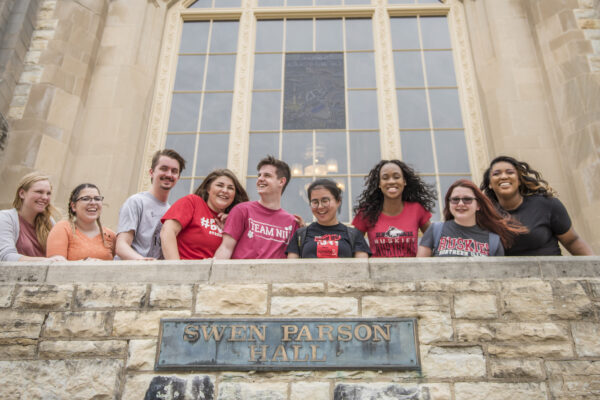By Brad Farnsworth
This post is part of the series Beyond the Margins: Meeting the Needs of Underserved Students.
Over one million international students are currently studying in the United States. While their economic contributions to this country tend to be a primary focus, they also bring cultural, political, and historical perspectives that help build vibrant, diverse campus communities.
There is tremendous diversity within the international student population at American colleges and universities, with important differences in English language ability, family income, and educational goals. Nevertheless, they are all subject to the same legal and regulatory constraints. Uncertainty over the visa application process alone is a source of great anxiety, and foreign citizenship places important restrictions on eligibility for financial aid and access to work experience. Perhaps most important of all, statements by the current administration, reinforced by the recent Supreme Court ruling upholding the administration’s travel ban, have sent a strong message that the United States is no longer a welcoming environment for international students and scholars.
The decline in new international student enrollments has led some institutions to invest more heavily in marketing and recruiting. Others are beginning to think more holistically about the entire international student experience, from initial contact through alumni status. While institutions cannot change the visa policies of the U.S. government—at least not by acting individually—there is much they can do to improve the quality of the international student experience on their own campuses.
Creating inclusive learning and social environments
Most international students arrive in the United States with the expectation that they will learn more about this country and have meaningful interactions with Americans—interactions that go beyond commercial exchanges and small talk in the student cafeteria. Even for the students who arrive in the United States with the relatively narrow goal of earning an academic credential in a technical field, learning how to engage another culture is a valuable professional skill.
My own recent experience teaching in the MBA program at the University of Michigan reminded me of this. My class was about 40 percent international students; most of them actively participated in class discussion, proving to be a valuable source of examples, personal experience, and contrasting perspectives. I felt very fortunate, but it also led me to question whether my experience was exceptional. Could these students be self-selected, paying a small fortune in tuition to gain access to a learning environment where they will get as much from their talented fellow students as they will from listening to their teacher?
There are proven strategies that will help international students succeed in the classroom. Based on my own experience, these include using clear, colloquial-free language; providing discussion questions in advance; basing classroom discussion on a single, fairly short reading; and building in time for small-group work in advance of a full classroom discussion.
Building a campus community where international students are fully integrated into the learning process and social environment can benefit everyone. Domestic students—and especially those without the time or money to study abroad—may have their only meaningful cross-cultural experience while interacting with international students on their home campus. And there are substantial benefits to creating a diverse and inclusive campus community where all students feel equally welcome and engaged. Research shows that when students are exposed to individuals from other groups or those who are different from themselves, this can lead to cognitive growth and lower levels of prejudice.
Boston University’s Howard Thurman Center for Common Ground is an example of an institution with dedicated space that exposes students to diversity in educationally purposefully ways. It is a space where people from different races/ethnicities, cultures, ideologies, orientations can focus on shared humanity and civil discourse centered on listening, conversation, and hospitality. The Center, according to one student, “is a catalyst of my social engagement and awareness and especially being able to have a worldview or mindset that is global.” With international students accounting for almost a quarter of the student population, the Center strives to incorporate them into its mix.
Managing mental health issues
Inherently tied to learning and social environments and an emerging area of concern in all of higher education is the mental health of students. The recent statistics are alarming, with some estimating that one in five have a mental health issue, with the vast majority of these cases going undiagnosed and untreated. As institutions work through this sensitive and complicated issue, they should consider the special needs of international students, whose self-reported emotional and stress-related problems have been increasing over time. International students have the additional pressures of adapting to an unfamiliar academic environment while simultaneously dealing with language barriers, culture shock, homesickness, financial pressures, and newfound personal independence.
Seeking assistance falls short for several reasons. International students may come from countries with vastly different norms when it comes mental health. This can prevent some students from seeking timely assistance or interfere with managing symptoms, or recognizing the warning signals of excessive stress and anxiety and the impact certain stressors can have on their overall well-being, as research with Chinese international students underscores. They also may not understand how to use the health care system in the United States. They may also underappreciate the costs of delaying intervention and be intimidated by the need to communicate their symptoms in a foreign language.
Institutions can disseminate information on mental health at various points throughout the year rather than overwhelm international students during orientation. Key information should include clearly defined terms, policies, and procedures; the warning signals for mental illness; and resources, including the campus health care system.
A greater sense of belonging can be cultivated through mentoring initiatives such as the Columbia Mentoring Initiative (CMI) at Columbia University. CMI connects first-year students with upper classmen and alumni, focusing on academic skills, social and emotional health, and leadership and identity development.
Multiple channels of engagement, including focus groups, social media, interviews, or campus climate surveys will help campuses regularly assess the emotional needs of their international students. The University of Denver, for example, conducted a campus climate survey that focused on three subsets of minoritized student populations, including international students, to provide recommendations for improving their postsecondary experience.
Negotiating professional development and work opportunities
Many international students come to the United States hoping to obtain work experience in addition to a high-quality education or university degree, and they are often frustrated by the constraints imposed by U.S. immigration law. While individual institutions cannot control visa policy, research shows that some international students arrive on our campuses with unrealistic expectations about work opportunities following graduation.
Institutions can manage student expectations more effectively if they begin the discussion of work options before applicants leave their home country, and they should continue those conversations as soon as international students arrive on campus. Another option is to help students become more attractive candidates for work experience through summer internships, part-time work on campus, or full-time work following graduation.
Fortunately, U.S. immigration law allows international students to obtain work experience while still under their student visa, either during or immediately following their academic work. According to the 2017 Open Doors report, 16 percent of international students engage in some kind of post-completion work experience, even though a 2017 World Education Services survey found that 75 percent of students expressed interest in participating in work training options post-graduation.
Institutions could begin to address this gap by offering employers a menu of engagement options, from service learning projects to internships to consulting assignments. Employers in turn could provide expertise and advice on experiential learning projects, enhanced English language training, and extra-curricular activities that accurately simulate the cultural conditions of the work environment and promote interactions with Americans. Such partnerships need to be supplemented with information on the nuts-and-bolts of hiring international students, as UC Berkeley has done through its U.S. Employer’s Guide to Hiring UC Berkeley International Students.
Pulling it all together
ACE strongly encourages our members to adopt a strategic and comprehensive approach to internationalization. For institutions that want to strengthen their approach to international students, this means addressing the entire international student experience, from first contact through alumni status. It also means that institutions should develop their goals for international students in parallel with the development of their goals for the curriculum, co-curriculum, international partnerships, and faculty development. Some of our members choose to participate in our Internationalization Laboratory, an ACE program that guides institutions through an analysis of all international programming, eventually leading to a strategic plan for internationalization for the entire institution.
Some institutions have already taken the strategic approach. Michigan State University (MSU) has an approach that emphasizes communications, community outreach, health and well-being, funding opportunities, career advising, and service learning opportunities. MSU offers pre-departure orientation for some students and family members in addition to having a website in Mandarin for Chinese parents. It also partners with an international counseling organization to provide free, culturally responsive mental health services for international students, staff, and faculty. Recognizing the financial hardships some international students face, MSU provides emergency tuition assistance in addition to competitive writing competitions and scholarships.
ACE also advocates for national policies that encourage international students to study in this country. We will continue to express concerns over policies that directly or indirectly discourage students from coming to this country, as we have done with the travel ban. We have also undertaken a major research project to aggregate research on international students, especially research that focuses on their overall levels of satisfaction.
Here at ACE, we would like to hear from you. What is working well at your institution? Do you have examples of effective programs and practices? What are your greatest challenges? If you are experiencing declining enrollments, how are you responding?
If you have any questions or comments about this blog post, please contact us.



